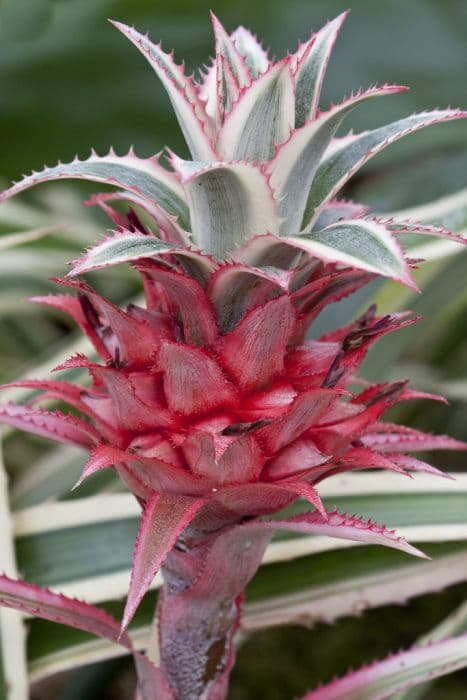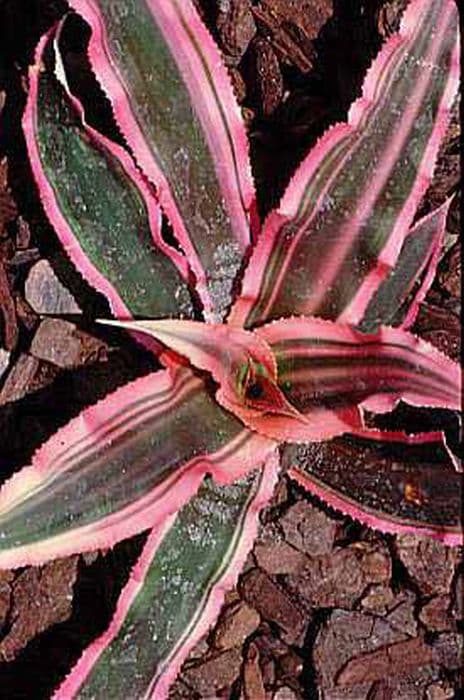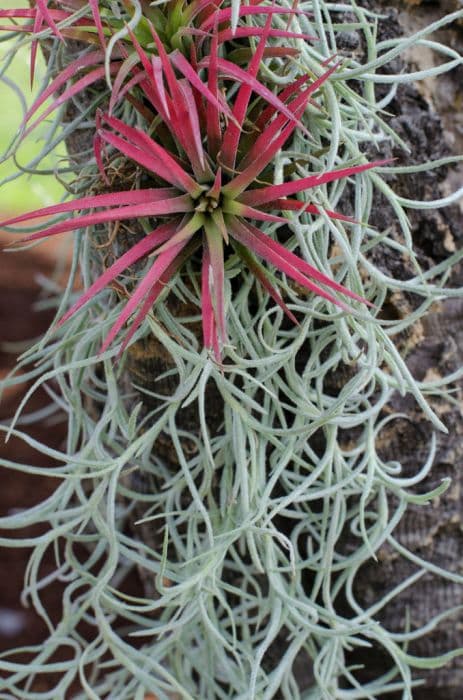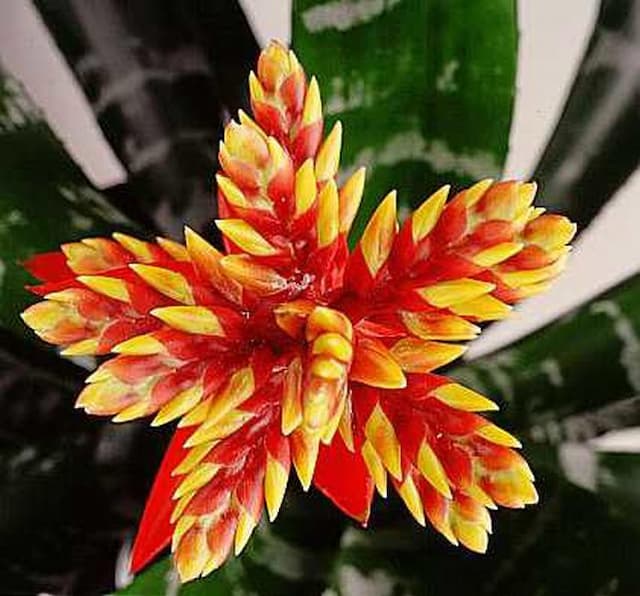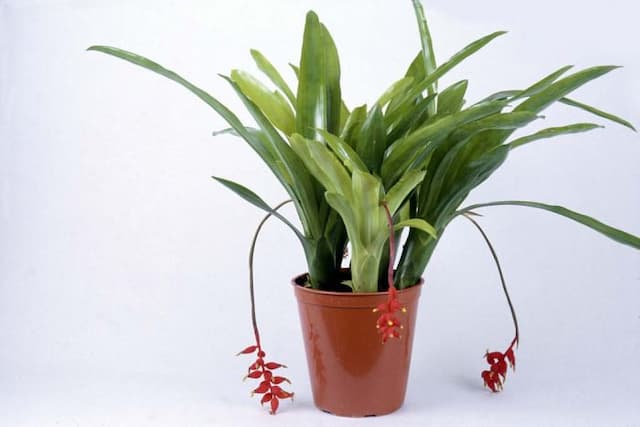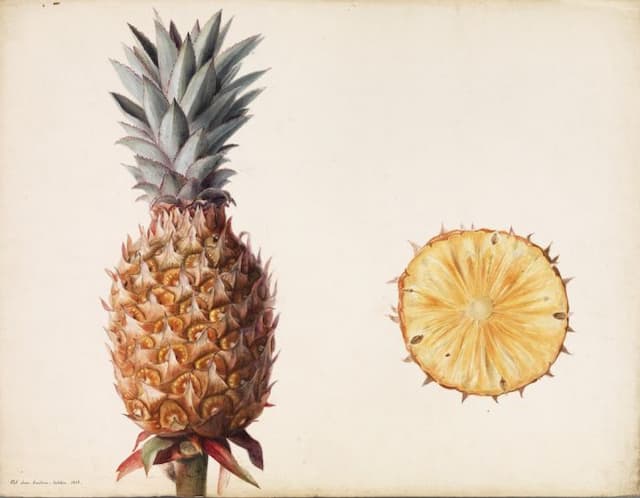Medusa's Head Tillandsia caput-medusae

ABOUT
Tillandsia caput-medusae, also known as the Medusa's head air plant, is a distinctive and fascinating plant due to its unique shape and growth pattern. Its leaves are thick, fleshy, and recurving, similar to the serpentine locks of Medusa in Greek mythology. The appearance can range from a silver-green to a grayish color, depending on the light exposure and environment. The plant's leaves are coated with small scales known as trichomes, which give them a velvety or fuzzy texture and help the plant absorb water and nutrients from the air. The Medusa's head air plant blooms with a colorful inflorescence, typically with purple flowers emerging from a red or pink spiky bract, offering a bold contrast against the softer hues of the leaves. This bloom adds to the visual interest and appeal of the plant. The overall aesthetic of Tillandsia caput-medusae is one of an otherworldly organism, with an almost alien shape and texture, making it a unique addition to any plant collection.
About this plant
 Names
NamesFamily
Bromeliaceae
Synonyms
Medusa's Head, Octopus Plant, Air Plant
Common names
Tillandsia caput-medusae.
 Toxicity
ToxicityTo humans
Medusa's head, which is the common name for Tillandsia caput-medusae, is not known to be toxic to humans. There are no well-documented cases of poisoning from ingesting any part of this plant, and it is generally considered safe to handle.
To pets
Medusa's head is not known to be toxic to pets either. This plant is generally recognized as safe for cats, dogs, and other household pets, with no reported cases of poisoning from ingestion. It should not pose a risk if a pet comes into contact with or ingests part of it.
 Characteristics
CharacteristicsLife cycle
Perennials
Foliage type
Evergreen
Color of leaves
Green
Flower color
Purple
Height
6-12 inches (15-30 cm)
Spread
6-12 inches (15-30 cm)
Plant type
Air plant
Hardiness zones
9
Native area
Central America
Benefits
 General Benefits
General Benefits- Low Maintenance: Tillandsia caput-medusae, commonly known as Medusa's head, requires minimal watering and no soil, making it easy to care for.
- Adaptability: It can grow in a variety of conditions, from bright indirect light to shadier spots, making it a versatile plant for different indoor environments.
- Decorative Appeal: With its unique, snake-like leaves, Medusa's head adds a dramatic and exotic touch to interior décor.
- No Soil Needed: This plant absorbs nutrients and water through its leaves from the air, eliminating the need for soil and reducing mess.
- Perfect for Terrariums: Medusa's head is well-suited for terrariums or being mounted on different surfaces, offering creative display options.
- Drought-Tolerant: Owing to its ability to store water, Medusa's head can withstand periods of drought, making it ideal for those who may occasionally forget to water their plants.
- Non-Toxic: It is safe for homes with pets, as it is not toxic to cats or dogs.
- Reproduction Through Pups: The plant can reproduce by producing pups or offsets, which can be detached to grow new plants once they're a reasonable size.
 Medical Properties
Medical PropertiesThis plant is not used for medical purposes.
 Air-purifying Qualities
Air-purifying QualitiesThis plant is not specifically known for air purifying qualities.
 Other Uses
Other Uses- Biodegradable Art Material: Tillandsia caput-medusae can be incorporated into eco-friendly sculptures and installations, decomposing naturally after the artwork is no longer displayed.
- Jewelry Pieces: The plant can be used in living plant jewelry, such as necklaces or earrings, often with the plant encapsulated in a transparent locket or frame.
- Education and Research: It is utilized by teachers and scientists to educate about epiphytic plants’ growth without soil and their water and nutrient absorption through leaves.
- Wedding Decor: Because of its unique look, Tillandsia caput-medusae is often used in wedding bouquets, boutonnieres, and centerpieces as a sustainable decor option.
- Sound Absorption: When used in large numbers, these plants can help dampen sound, making them useful in creating quieter, more serene interior spaces.
- Photography Props: The plant's distinctive appearance makes it an excellent subject or backdrop for macro and botanical photography.
- Fashion Inspiration: Its alien-like structure inspires designers for patterns and elements in the fashion industry, from textiles to accessories.
- Seasonal Decorations: It can be incorporated into seasonal wreaths or ornaments for holidays, adding a unique twist to traditional decor.
- Feng Shui: Some people believe that Tillandsia caput-medusae helps in balancing energy when placed in specific areas of a home or office according to Feng Shui principles.
- Themed Events: It can be used in themed events, such as science fiction parties or natural history museum exhibits, to create an exotic atmosphere.
Interesting Facts
 Feng Shui
Feng ShuiThe air plant is not used in Feng Shui practice.
 Zodiac Sign Compitability
Zodiac Sign CompitabilityThe air plant is not used in astrology practice.
 Plant Symbolism
Plant Symbolism- Air Element: The Tillandsia caput-medusae, commonly known as the Air Plant, represents the element of air as it does not require soil to grow, symbolizing freedom and spirit.
- Resilience: This plant's ability to thrive in various climates and conditions is a testament to its adaptability, making it a symbol of perseverance and resilience.
- Uniqueness: With its distinct shape and appearance that resembles the head of Medusa, the Air Plant symbolizes uniqueness and individuality.
- Protection: The name referencing Medusa, a figure whose gaze could turn others to stone, can be symbolic of warding off negativity and offering protection.
- Ethereal Beauty: The delicate and intricate forms of the Air Plant with its silvery foliage exemplify otherworldly or ethereal beauty, suggesting an appreciation for the less obvious or unconventional beauty.
 Water
WaterThe Medusa's Head needs to be watered roughly once a week by soaking it in water for 20 to 30 minutes. During the soaking, the entire plant should be submerged in water. After soaking, shake off the excess water and leave the plant to dry completely. In more humid environments, watering may be reduced to every two to three weeks. To maintain humidity, it can also benefit from occasional misting in between the soakings, especially during dry seasons.
 Light
LightThe Medusa's Head thrives best in bright, indirect sunlight. It should be placed where it can receive filtered light that replicates the light conditions of its natural forest canopy habitat. Avoid direct sunlight, which can scorch the leaves, especially during the peak hours of the day.
 Temperature
TemperatureThe Medusa's Head prefers temperatures between 50 to 90 degrees Fahrenheit, with optimal growth occurring around 70 to 80 degrees Fahrenheit. It can tolerate temperatures as low as 40 degrees Fahrenheit and as high as 100 degrees Fahrenheit, but these are not ideal for long-term health.
 Pruning
PruningPruning the Medusa's Head is generally not needed except to remove dead or damaged leaves to encourage healthy growth and for aesthetic reasons. The best time for pruning is during the growing season when the plant can recover more quickly.
 Cleaning
CleaningAs needed
 Soil
SoilMedusa's Head air plant doesn't require soil as it is an epiphyte, but if mounted, it prefers a slightly acidic pH around 5.5-6.0.
 Repotting
RepottingMedusa's Head air plant does not require repotting as it is not grown in soil but may need remounting every few years.
 Humidity & Misting
Humidity & MistingMedusa's Head air plant thrives in high humidity environments, around 50-70%.
 Suitable locations
Suitable locationsIndoor
Mount on wood or place in a terrarium with bright, indirect light.
Outdoor
Hang or mount in bright shade, sheltered from full sun and heavy rain.
Hardiness zone
9-11 USDA
 Life cycle
Life cycleTillandsia caput-medusae, commonly known as Medusa's head, begins its life cycle as a seed dispersed by wind, due to its small size and lightweight structure. Upon landing in a suitable environment, often on a tree, rock, or other structure, it germinates and develops a root system used primarily for anchorage. As it grows, it absorbs moisture and nutrients through its leaves by a process called atmospheric nutrition, a characteristic of air plants. It reaches maturity and produces a rosette of leaves, within which a striking inflorescence may grow, showcasing tubular flowers that attract pollinators. After flowering, the plant will eventually produce offsets, or "pups," at its base, which grow independently, perpetuating the species. The parent plant slowly senesces and dies after the pups have formed, completing its life cycle.
 Propogation
PropogationPropogation time
Spring-Early Summer
The most popular method of propagating Tillandsia caput-medusae, commonly known as the Medusa's head air plant, involves using offsets, or "pups," that the parent plant produces naturally. These pups usually form at the base of the plant after it flowers and can be harvested once they are about one-third the size of the mother plant. Carefully twist and pull the pup from the mother plant or use a sharp, sterilized knife to separate them, ensuring each pup has a portion of the base to allow for independent growth. These separated pups can be placed in a bright, indirect light setting and should be misted regularly to maintain proper humidity. With the right care, they will eventually grow into mature Tillandsia caput-medusae plants, continuing the cycle of life for this unique species.

